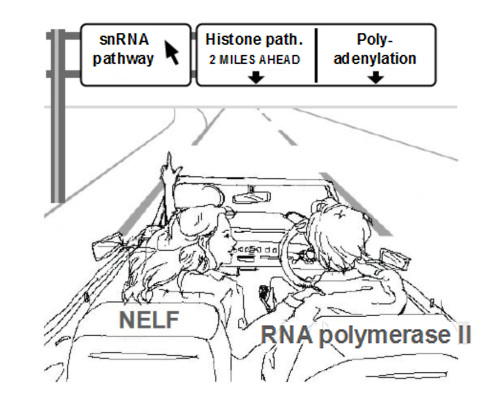Mechanism controlling the length of RNA made during transcription revealed: New findings could help treatments for cancer
Summary
Scientists at Tokyo Institute of Technology, the Graduate School of Bioscience and Biotechnology have revealed that a protein called NELF controls the length of RNA produced by RNA polymerase II. RNA polymerase II is the molecular engine of gene expression, responsible for the expression of most cellular genes. Yuki Yamaguchi, Junichi Yamamoto and colleagues identify the fundamental mechanism by which the fate of RNA polymerase II during transcription is determined by its binding protein, NELF. The research is not only interesting in itself but also sheds new light on how cancer progresses.
RNAs of different lengths and functions are synthesized in our cells (Figure 1). There are three distinct RNA processing (1) pathways, and where RNA polymerase II stops RNA synthesis is precisely controlled on a gene-by-gene basis. "When the function of NELF was inhibited, RNA processing pathways were altered, and abnormally long, misprocessed RNAs were made from snRNA (2) genes and histone (3) genes," explain the authors (Figure 2). Cells could not survive in the absence of NELF, because these functionally important genes would not be expressed. Recent studies have shown that cancer cells produce generally shorter RNAs than normal cells, although the underlying mechanism is unclear. The new findings could help elucidate the mechanism and lead to to the development of new methods for controlling the growth of cancer.
These findings were published online in Nature Communications, a premier journal in the UK, on June 27, 2014.

Figure 1. Three types of RNAs synthesized by RNA polymerase II

Figure 2. NELF is the key to appropriate control over the RNA length
Explanation of Technical Terms
1. RNA processing: |
RNAs newly synthesized by RNA polymerase II are "premature" and require additional processing reactions to be mature and functional. Particularly, RNA termini are precisely generated by 3' processing, a form of RNA processing reactions; in other words, the lengths of mature RNAs are determined by 3' processing. A few hundred consecutive adenine residues are attached to messenger RNAs produced from most protein-coding genes, whereas snRNAs and messenger RNAs produced from histone genes do not have such a structure (see Figure 1). |
2. snRNA: |
While messenger RNAs convey genetic information from DNAs to proteins, snRNAs do not, but instead play an important role as functional RNAs in splicing and are critical for the removal of intervening sequences from messenger RNAs. |
3. Histone: |
Histones are proteins that tightly package genomic DNA into chromosomes. |
Reference
Authors: |
Junichi Yamamoto, Yuri Hagiwara, Kunitoshi Chiba, Tomoyasu Isobe, Takashi Narita, Hiroshi Handa, Yuki Yamaguchi |
Title: |
DSIF and NELF interact with Integrator to specify the correct post-transcriptional fate of snRNA genes |
Journal: |
Nature Communications |
DOI: |
|
. Any information published on this site will be valid in relation to Science Tokyo.




